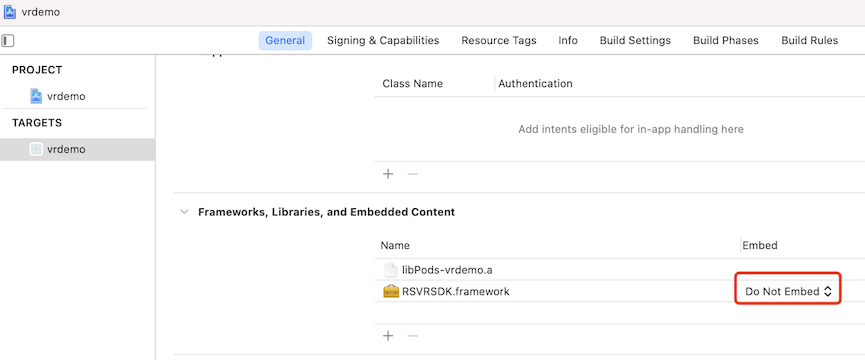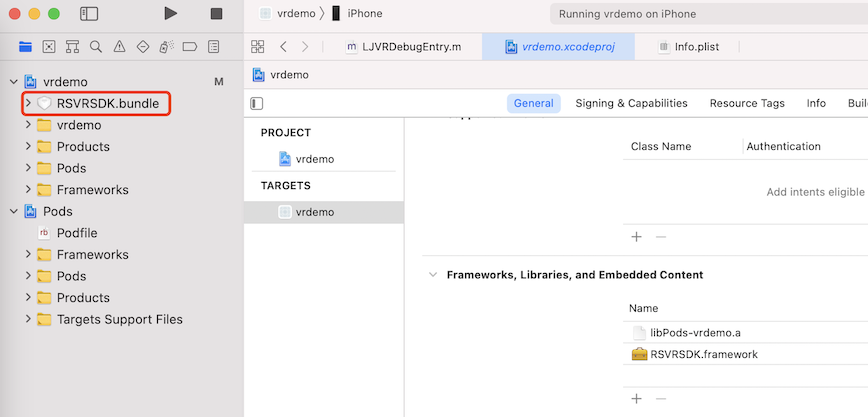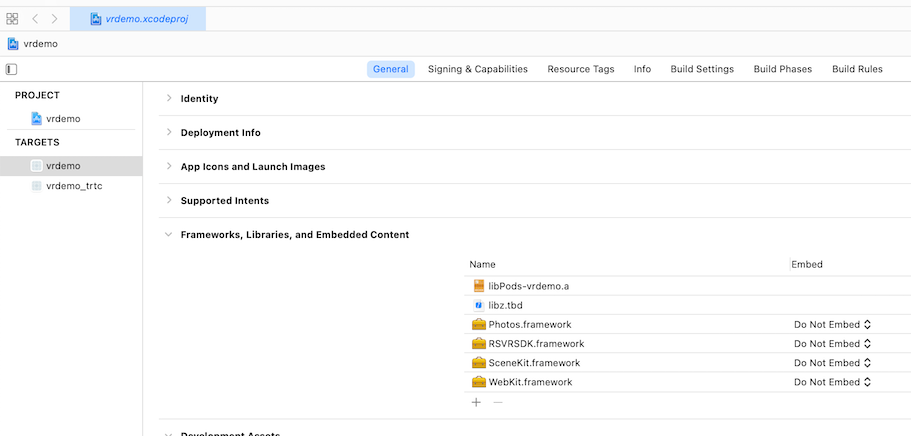iOS party
This document is in front of iOS developers, in the description that follows, we assume you already have an iOS development basics and installed Xcode related development environments.
This document is not yet complete and its content is for reference purposes only.
Download address
If you see two versions of SDK:basicsandwith revision.
- Base version:provides basic VR container capabilities such as full-screen browsing, vibration, keeping screen on and detecting microphone.If you only need to view VR features, it is recommended that you integrate this version.
- with version:contains basic version and includes TRTC to support real-time voice.Installing volume will be much larger than the base version and you are recommended to integrate this version if you need to support domestic online visibility features.
| Type | SDK | DEMO | Installation increment |
|---|---|---|---|
| Base Version | rsvrsdk_lite-1.0.16 | demo | About 4M |
| Take Version | rsvrsdk-1.0.16 | demo | About 18M |
Environmental requirements
- Xcode 11.0 and above.
- Make sure your project has a valid developer signature.
- Please make sure you have a real opportunity to debug.
Apply SDK access key
Please apply to the developer center for access key containing app_id and app_secret.
Integration step
Introduce SDK
First download RSVRSDK, decompress the:package and put it in the project directory.
Add RSVRSDK.framework:in Frameworks under General of project Target

Set Embed to Do Not Embed:

Introducing RSVRSDK resource files RSVRSDK.bundle

Add framework dependency
Add SDK dependencies Framework (Photos,libz,SceneKit,WebKitetc.):

Add Third Party Dependencies
Since RSVRSSDK relies on some third-party open source libraries, it is necessary to introduce the Podfile in the main project.
# Methods for VRSDK
pod 'FMDB'
pod 'Mantle'
pod 'AFNetworking', '3.2.1'
pod 'YYCache'
pod 'YYModel'
pod 'Masonry'
Apply for related permissions
RSVRSDK will use save to album. You will need to configure permission request in info.plist:
<key>NSPhotoLibraryAddUsageDescription</key>
<string>Using album</string>
Initialize SDK
RSVRSSDK initialization requires introducing header files
// import VR SDK header
#import <RSVRSDK/RSVRSDK.h>
#import <RSVRSDK/RSVRSDKConfig.h>
Provides initialization configuration
- (void)configVR {
[RSVRSDKConfig shareInstance].appInfo.scheme = @"xxxxx";
[RSVRSDKConfig shareInstance].appInfo.appId = @"appid";
[RSVRSDKConfig shareInstance].appInfo.appSecret = @"appSecret";
[RSVRSDKConfig shareInstance].appInfo.userAgent = @"xxxx";
}
Enable VR Page
Once initialization is complete, by call:
RSVREntity *param = [[RSVREntity alloc] init];
// Configure open URL
param.vrUrl = @"http://xxx/vrurl";
UIViewController *vc = [RSVRSDK VRWebViewWithParam:param];
// Open VR page
[self.navigationController pushViewController:vc animated:YES];
Since then, iOS RSVRSDK basic features have been integrated.
Custom Protocol
MicroMessage Sharing
RSVRSDK supports functions such as calling WeChat to share to applets, copying links, etc. To use the WeChat sharing function, you need to perform the following operations:
// Introducing Micromessage-Sharing SDK
pod 'WechatOpenSDK'
If using base version, no VR sharing feature is included, you can customize sharing logic :
#pagma RSVRSDKDelegate
...
/// H5 pages call json on share
/// @param sharedJson H5 page on shared
- (void)shareWithParam:(NSString *)sharedJson {
// completely customize sharing, This proxy callback can be implemented
// sharedJson is a json string sharing data
// Can be shared via shareJson custom UI shared
}
/// When users click on item callback
/// @param shadeModel Share item
- (void)didShareItemClick:(RSVRShareBaseModel *)shareModel {
// Implement this proxy method, Shared UI will be implemented internally by SDK
// When users click on sharing icon, this proxy method will be called
// available through shareModel. xtraData get customized data for the business party
// ⚠️ if shareWithParam: with didShareItemClick:, will only back shareWithParam:
}
Custom Loading
The SDK supports the operator to customize the Loading Background and Logo on the VR page.
When constructingVRParam, customize as follows:
NSString *url = @"http://open-rushivr.cn/xxxxx";
NSString *logoUrl = @"http://xxxcdn.com/logo. ng";
RSVRParam *param = [[RSVRParam alloc] init];
[param setVrUrl:url];// to open VR link
[param setLogoUrl:logoUrl]; // Custom LoadingLogo, recommend specification:broad, high 111, resolution 72, background transparency.
[param setLoadingImage:loadingImage]; // Custom LoadingPage Background Image
[param setLoadingType:E_RSSVRSDKLoadingTypeTypeDefault]; // Custom LoadingType
UIViewController *vc = [RSVRSDK VRWebViewWithParam:param];
[self.navigationController pushViewController:vc animated:YES];
callAndBackfeed
Send scheme information to the client. The client will return to the front end when it receives the message.
Protocol format:
{
"type": "callAndBackFeed fixed value, defined",
"param": {
"actionUrl": "a specific jsBridge",
"functionName": "Callback to The callback method name on the frontend side."
}
}
Frontend side:
import JSBridge from "@realsee/jsbridge-x";
const jsBridge = new JSBridge();
jsBridge.callAndBackfeed("custom/showQrCode?url=http%3A%2F%2Fwww.realsee.com");
App side:
/// This method can be implemented to handle scheme
that cannot be processed by an RSVRSDK instance /// @param urlString scheme url
/// @param finishBlock scheme callback
- (void)actionURL:(NSString *)urlString withFinishBlock:( finishBlock _Nullable)finishBlock
{
NSURL* url = [NSURL URLWithString:urlString];
if (url && [@"/custom/showQrCode" isEqualToString:url.path]) {
finishBlock(@"1"); //callback notify frontend
}
}
callAndListen
Send scheme information to client, client listens to changes in the status and will send back back to the frontend by callback when the status changes occur.
Protocol format:
{
"type": "callAndListen", // fixed value, already defined
"param": {
"actionUrl": "", // a specific jsBridge
"functionName": "App", // terminal The name of the callback method that is called back to the front end after an operation is executed.
}
}
Frontend side:
import JSBridge from "@realsee/jsbridge-x";
const jsBridge = new JSBridge();
jsBridge.callAndListen("custom/listenWebViewState", (newState) => {
// 监听的客户端状态发生变更
});
App side:
/// This method needs to be implemented to handle some H5 schemes that the VR SDK does not handle, for example: web/compaign
/// @param urlString sscheme url
/// @param finishBlock scheme callback
- (void)actionURL:(NSString *)urlString withFinishBlock:(RSVRSchemeFinishCallback _Nullable)finishBlock {
NSURL* url = [NSURL URLWithString:urlString];
if (url && [@"/custom/listenWebViewState" isEqualToString:url.path]) {
finishBlock(@" START"); //Callback to inform the front end to start
......
finishBlock(@"PAUSE"); //Callback to notify the front end to pause
......
finishBlock(@"STOP"); // Callback to notify frontend to stop
}
}